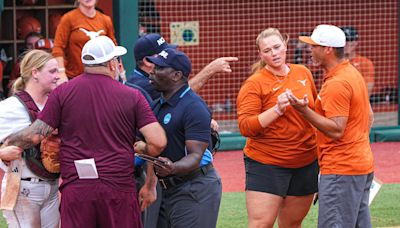Search results
Texas (/ ˈ t ɛ k s ə s / TEK-səss, locally also / ˈ t ɛ k s ɪ z / TEK-siz; Spanish: Texas or Tejas, pronounced) is the most populous state in the South Central region of the United States. It borders Louisiana to the east, Arkansas to the northeast, Oklahoma to the north, New Mexico to the west, and the Mexican states of Chihuahua ...
- Republic of Texas
The Republic of Texas (Spanish: República de Tejas), or...
- Flag of Texas
The flag of Texas is the official flag of the U.S. state of...
- Senate
The Texas Senate is the upper house of the Texas...
- United States Congressional Delegations From Texas
Texas's congressional districts since 2023. These are tables...
- Talk
Texas is the second-most populous state in the United States...
- Austin
Austin (/ ˈ ɔː s t ɪ n / AW-stin) is the capital of the U.S....
- Six Flags Over Texas
Six Flags Over Texas is a 212-acre (86 ha) amusement park,...
- List of Texas Metropolitan Areas
The following is a complete list of 25 metropolitan areas in...
- Republic of Texas
- Padre Islands National Seashore. Windswept dunes waving with coastal grasses set the scene on this barrier island that runs 182 kilometers along the Gulf of Mexico coast.
- San Antonio River Walk. This bustling walk lives up to its name, running so close to the gentle San Antonio River you feel you could step right into it.
- Guadalupe Mountains National Park. This honey-colored ridge formed 250 million years ago and is actually a rare fossil reef. Explore its remote beauty through backcountry camping and hiking or get out your binoculars, as the birding is great here.
- The Alamo. Site of the famous battle of the Texas Revolution and the most visited landmark in Texas, the mission and its grounds are accessible through multiple tours, and interactive exhibits and history talks get guests up to speed on what “Remember the Alamo” means to Texans.
- Overview
- Relief
Texas, constituent state of the United States of America. It became the 28th state of the union in 1845. Texas occupies the south-central segment of the country and is the largest state in area except for Alaska. The state extends nearly 1,000 miles (1,600 km) from north to south and about the same distance from east to west.
Water delineates many of its borders. The wriggling course of the Red River makes up the eastern two-thirds of Texas’s boundary with Oklahoma to the north, while the remainder of the northern boundary is the Panhandle, which juts northward, forming a counterpart in the western part of that state. The Sabine River forms most of the boundary with Louisiana to the east, where by land it is bounded by Arkansas as well. The crescent-shaped coastline of the Gulf of Mexico lies to the southeast, and the Rio Grande carves a shallow channel that separates Texas from Mexico to the southwest. The state of New Mexico lies to the west. Austin, in the south-central part of the state, is the capital.
The vastness and diversity of Texas are evident in nearly all aspects of its physical features, economy, history, and cultural life. The territory of Texas was part of the Spanish Empire for more than a century. It was then part of the new country of Mexico from 1821 to 1836, when it gained its independence, and had a short-lived existence as a republic before joining the Union. The image of Texas was that of a raw and lawless frontier when it relinquished its independence to become a state. Although Texans still identify strongly with their cowboy heritage, the state’s image of Texas changed dramatically over the course of the 20th century; present-day Texas is known for its great agricultural wealth, major oil and natural gas production, industry and finance, huge urban centres that foster a cosmopolitan cultural life, and seemingly unending stretches of high prairie and ranges devoted to cattle and cotton.
The name of the state derives from the Caddo word thecas, meaning “allies” or “friends.” (The Spanish spelled the word tejas or texas and used it to describe the area where this Native American tribe lived.) Texas is commonly divided into East and West, although the dividing line between the two is ambiguous. Generally, though, East Texas has a wet climate and is characterized by cotton and by ties to the Old South, while West Texas is dry and is known for cattle ranching and an affinity with the West. Area 268,597 square miles (695,662 square km). Population (2020) 29,145,505; (2023 est.) 30,503,301.
Britannica Quiz
U.S. State Nicknames Quiz
Texas comprises a series of vast regions, from the fertile and densely populated Coastal Plains in the southeast to the high plains and mountains in the west and northwest. Stretching inland from the Gulf Coast, the Coastal Plains, encompassing about two-fifths of the state’s land area, range from sea level to about 1,000 feet (300 metres) in elevation. These flat, low prairies extend inland to form a fertile crescent that is well adapted to farming and cattle raising. Near the coast much land is marshy, almost swamp, except where drained by man-made devices.
The Coastal Plains ends at the Balcones Escarpment, where tremors have occurred. Northwest of this fault, the land extends into the Texas Hill Country and into the tablelands of the Edwards Plateau to the south and the North Central Plains to the north. The entire region varies from about 750 to 2,500 feet (200 to 750 metres) above sea level, and farming and livestock raising constitute the basic economy. In Hill Country there are small industries and recreational areas.
Exclusive academic rate for students! Save 67% on Britannica Premium.
Learn More
The North Plains subdivision, centred on Amarillo, depends on grain farming, ranching, oil, and small industries. The South Plains subdivision, with Lubbock as the principal city, has large underground water reservoirs that allow large-scale irrigated cotton farming.
At the western edge of the North Central Plains lies the Caprock Escarpment, an outcropping of rock that stretches to the north and south for about 200 miles (320 km). Beyond that escarpment lies the third largest region of Texas, the High Plains country, and to the south lies the Trans-Pecos region.
Texas is the most populous state in the South Central region of the United States. It borders Louisiana to the east, Arkansas to the northeast, Oklahoma to the north, New Mexico to the west, and the Mexican states of Chihuahua, Coahuila, Nuevo León, and Tamaulipas to the south and southwest.
Oct 5, 2023 · Learn everything you need to know about exploring the Lone Star State, from its cities and parks to its culture and cuisine. Find out when to go, where to stay, what to do, and how to get around in this comprehensive guide.
People also ask
Is Texas a US state?
What is the largest state in Texas?
When did Texas become a state?
Is Texas a good state?
Texas (/ ˈ t ɛ k s ə s /, also locally / ˈ t ɛ k s ɪ z / American Spanish: ), officially the State of Texas, is a state in the South Central Region of the United States. It is the second largest US state by total area (after Alaska ) with 268,596 sq mi (695,662 km 2 ) and population (after California ) with nearly 29 million people as of ...





